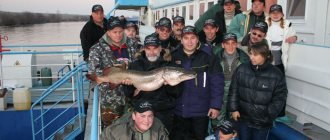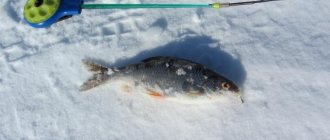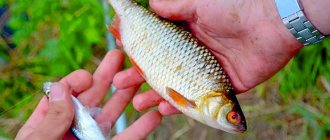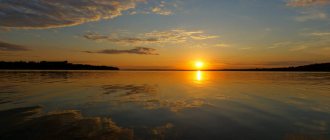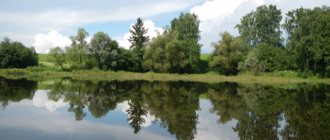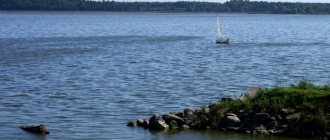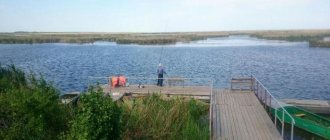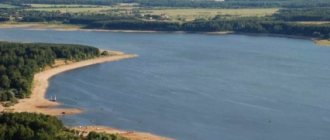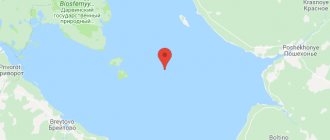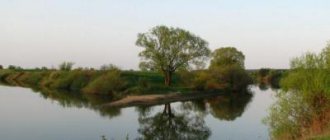Description of the Verkhneruzskoye Reservoir
Total volume 40 million m³, area 9.4 km². Width up to 2.8 km, length about 20.5 km, depth up to 12 m. Fluctuations in water level up to 2 meters.
Located at an altitude of 209 meters above sea level. Formed by an earthen dam 500 meters long.
The Verkhneruzskoe reservoir freezes at the end of November and opens at the end of April.
It is used for water supply to Moscow (supplying water to the Rublevsky hydroelectric complex), as well as regulating the flow of the Ruza River. Popular vacation spot.
Who to catch on the Verkhneruzskoye Reservoir
A famous fishing spot among amateur fishermen. In winter, spring, autumn and summer the following fish are caught in the reservoir: bream, pike, pike perch, perch, roach, ruffe, bleak, silver bream, and less often burbot.
On the banks are the village of Cherlenkovo, the villages of Sutoki, Shchemelinki, Romantsevo, Filenino and several holiday villages.
The capture of a 3-5 kg “crocodile” pike in these places is not uncommon, despite the fact that there is plenty of small “forage” fish in the reservoir. The thing is that in the Verkhneruzsky Reservoir, pike and other fish actively feed throughout the winter. If in other reservoirs the pike's zest occurs at the very end of the freeze-up, then in the Verkhneruzsky Reservoir the pike bite is even throughout the winter, and the activity of the predator increases already in early March. This is due to the very good circulation of water, which is “driven” by the pumps of the water station located nearby on the Yauza-Ruza connecting canal. Because of this, there are many gullies and generally non-freezing wormwood on the reservoir.
Where to catch large pike on the Verkhneruzsky Reservoir
Most of the pike are in the western part of the reservoir, especially near the confluence of the Duba and Chernaya rivers, but you can only get there by taking a detour along the shore on a motor sleigh, which is available at the fishing base located in the village of Filenino. But the price of transportation is quite high - 1,500 rubles per person one way. When going to pike places, you need to move where the ice is reliable.
Having arrived at the place, you can easily catch live bait - small perch or roach; they can be found everywhere along the coast, especially in snags.
Fishing for pike on girders on the Verkhneruzskoye Reservoir
If in other reservoirs we catch pike on specially equipped girders, the equipment of which uses an elongated, at least 0.5 m, leash made of fishing line with a diameter of 0.35 mm (this fish will simply ignore coarser tackle), then on the Verkhneruzsky reservoir without metal, and you can’t do better than a soft Kevlar leash, because the pike fiercely resists when fishing. The reel of the fishing rod must have good braking inertia, otherwise when the pike stops in a classic manner, the line may be thrown off and tangled.
The girders are installed in a checkerboard pattern along the channel edge of the flowing rivers at a distance of 15–20 meters from each other. Sometimes some of the girders are installed in shallows and snags. However, a new person on a pond cannot always guess the exact location of the predator, therefore, after a long period of inactivity, it is recommended to move the girders to the side by 10–15 m or even look for a new fishing area.
The hole in which the girder is installed must be sprinkled with snow or covered with a piece of cardboard, which you must have with you, since in not very deep places the light penetrating into the water through the hole frightens the predator.
About fishing on the Verkhneruzskoye Reservoir
This rather remote body of water is located in the westernmost part of the Moscow region, surrounded by dense forests and famous for the abundance of pike, which here have quite plump forms. The capture of a 3-5 kg “crocodile” in these places is not uncommon, despite the fact that there are plenty of small “food” fish in the reservoir. The thing is that in the Verkhneruzsky Reservoir, pike and other fish actively feed throughout the winter. If in other reservoirs the pike's zest occurs at the very end of the freeze-up, here the picture is completely different, even throughout the winter, with an increase in biting activity already in early March. This is due to the very good circulation of water, which is “driven” by the pumps of the water station located nearby on the Yauza-Ruza connecting canal. That’s why there are a lot of gullies and generally non-freezing wormwood on the reservoir. Most of the pike are in the western part of the reservoir, especially near the confluence of the Duba and Chernaya rivers; you can only get here by taking a detour along the shore on a motorized sled, which is available at the fishing base located in the village of Filenino. But the transportation price is quite high - 1500 rubles. per person one way. When going to pike places, you need to move where the ice is reliable.
Having arrived at the place, you can easily catch live bait (small perch or roach), which can be found everywhere along the coast, especially in snags. If in other bodies of water they catch pike on specially equipped girders, in the equipment of which I use an elongated, at least 0.5 m leash made of 0.35 mm fishing line (it will simply ignore coarser tackle), then here without a metal, or better yet a soft kevralov leash get by - the pike barks so furiously when fishing. The reel of the fishing rod must have good braking inertia, otherwise, when the pike stops in a classic manner, the line may be thrown off and tangled. I install the drains in a checkerboard pattern along the channel edge of the flowing rivers at a distance of 15-20 m from each other. Sometimes some of the girders are installed in shallows and snags. However, a new person on a pond cannot always guess the exact location of the predator, therefore, after a long period of inactivity, it is recommended to move the girders to the side by 10-15 m or even look for a new fishing area. The hole in which the vent is installed must be sprinkled with snow or covered with a piece of cardboard, which you must have with you, otherwise in not very deep places the incident light will frighten the predator. In the spring, with the arrival of meltwater and revival in the underwater kingdom, small fish again concentrate in the snags and near the grass. Gears designed for fishing in snags have some special features. As you know, a pike, having grabbed a live bait, tends to go into cover. If the snag density is very high, the line reserve on the reel is left no more than 0.5 m. In this case, two tees are used on the leash, one of which (in a sliding position) is hooked at the base of the dorsal fin, and the other is hooked to the lip of the baitfish. This is done in order to increase the chances of hooking, at a time when the pike has not yet swallowed the bait. When fishing in snags, it is very important to constantly monitor the flags of the girders and, when biting, make a timely hook. Sometimes they catch fish in snags using a bait with a tee and a hook tied above it. In this case, the live bait is baited upside down - then the hook, hooked near the tail, and the tee sticking out of the mouth, fixes the vertical position of the fish. With this method of fishing, pike usually catch themselves. On the Verkhneruzskoye Reservoir, vertical trolling also gives good results. In the coastal zone, they are usually caught with small rounded “petal” type spoons, 20 x 40 mm in size, which often lure large perch. At depths, spinners with parameters of 20 x 70 mm are used, with a profile shape reminiscent of a pear. A pike spoon should glide well in the water, and the predator’s grip is often caused by intricate combinations of playing with the spoon. Usually, if after 7-10 strokes of the fishing rod there is no bite, they move to another hole. However, it happens that, returning to the old hole at a different time, you unexpectedly find yourself with a catch. This is due to the fact that pike can be in different parts of their habitat at different times of the day. If the activity of the predator does not stop all winter, the contour of this route can be quite wide. If we talk about catching other fish, burbot is poorly caught here due to the abundance of food, however, in March its activity noticeably improves. Burbot trails should be looked for along sandy and rocky steep banks, near the mouths of flowing rivers, where, according to my observations, in the spring its concentration is much higher than at other times. There are a lot of roaches in the reservoir, but large ones are extremely rare. On spring ice, you need to look for it along the pre-estuarine bays in the snags, at a depth of 3-4 m. The small undergrowth sticks to cleaner and deeper places, but sometimes it emerges onto shallow, pitted pre-channel tables. Those who do not like long journeys can catch the predator at the exit from Fileninsky Bay (on the right side), but such a catch as in remote areas of the reservoir is not guaranteed here, due to the fact that near the village the locals use nets. But usually I don’t leave here without a couple of pikes, and I’ll definitely take one or two burbots. You can get to these places by electric train from Rizhsky station to Shakhovskaya station, then by bus in the direction of Petushki to the village of Merklovo, then 3.5 km on foot to the village of Filenino. If you get there by your own transport, then you need to go along the Riga highway through Shakhovskaya and Sereda. The next one, after turning to Petushki, will be the village of Merklovo, from which the road will go to Filenino. There are 50 overnight accommodations at the Fileninskaya fishing base. Fishing with vouchers.
Fishing in spring on the Verkhneruzskoye Reservoir
In the spring, with the flow of melt water into the reservoir and the revival in the underwater kingdom, small fish again concentrate in the snags and near the grass.
Gears designed for fishing in snags have some special features. As you know, a pike, having grabbed a live bait, tends to go into cover. If the snag density is very high, the line reserve on the reel is left no more than 0.5 m. In this case, two tees are used on the leash, one of which (in a sliding position) is hooked at the base of the dorsal fin of the baitfish, and the other is hooked to its lip.
This is done in order to increase the chances of hooking, at a time when the pike has not yet swallowed the bait. When fishing in snags, it is very important to constantly monitor the flags of the girders and, when biting, make a timely hook. Sometimes fishing in snags is done using a tee with a tee and a hook tied above it. In this case, the live bait is baited upside down: a hook hooked near the tail and a tee sticking out of the mouth fix the fish in a vertical position. With this method of fishing, pike usually catch themselves.
An excerpt characterizing the Verkhneruzskoe reservoir
“I have the pleasure of being an acquaintance, if the countess remembers me,” said Prince Andrei with a polite and low bow, completely contradicting Peronskaya’s remarks about his rudeness, approaching Natasha and raising his hand to hug her waist even before he finished the invitation to dance. He suggested a waltz tour. That frozen expression on Natasha’s face, ready for despair and delight, suddenly lit up with a happy, grateful, childish smile. “I’ve been waiting for you for a long time,” as if this frightened and happy girl said, with her smile that appeared behind the ready tears, raising her hand on Prince Andrei’s shoulder. They were the second couple to enter the circle. Prince Andrey was one of the best dancers of his time. Natasha danced superbly. Her feet in ballroom satin shoes quickly, easily and independently of her did their job, and her face shone with the delight of happiness. Her bare neck and arms were thin and ugly. Compared to Helen's shoulders, her shoulders were thin, her breasts were vague, her arms were thin; but Helen already seemed to have a varnish on from all the thousands of glances sliding over her body, and Natasha seemed like a girl who had been exposed for the first time, and who would have been very ashamed of it if she had not been assured that it was so necessary. Prince Andrei loved to dance, and wanting to quickly get rid of the political and intelligent conversations with which everyone turned to him, and wanting to quickly break this annoying circle of embarrassment formed by the presence of the sovereign, he went to dance and chose Natasha, because Pierre pointed him out to her and because she was the first of the pretty women to come into his sight; but as soon as he embraced this thin, mobile figure, and she moved so close to him and smiled so close to him, the wine of her charm went to his head: he felt revived and rejuvenated when, catching his breath and leaving her, he stopped and began to look on the dancers. After Prince Andrei, Boris approached Natasha, inviting her to dance, and the adjutant dancer who started the ball, and more young people, and Natasha, handing over her excess gentlemen to Sonya, happy and flushed, did not stop dancing the whole evening. She did not notice anything and did not see anything that occupied everyone at this ball. She not only did not notice how the sovereign spoke for a long time with the French envoy, how he spoke especially graciously to such and such a lady, how prince such and such did and said this, how Helen was a great success and received special attention from such and such; she did not even see the sovereign and noticed that he left only because after his departure the ball became more lively. One of the merry cotillions, before dinner, Prince Andrei danced with Natasha again. He reminded her of their first date in the Otradnensky alley and how she could not sleep on a moonlit night, and how he involuntarily heard her. Natasha blushed at this reminder and tried to justify herself, as if there was something shameful in the feeling in which Prince Andrei involuntarily overheard her.
Sheer trolling on the Verkhneruzskoe reservoir
On the Verkhneruzskoye Reservoir, vertical trolling also gives good results. In the coastal zone, we usually catch pike with small rounded “petal” lures measuring 20x40 mm, which often lure large perch. When fishing at depths, spoons measuring 20x70 mm are used, with a profile shape resembling a pear.

A pike spoon should glide well in the water, and the predator is often provoked into grabbing by intricate combinations of playing with the spoon. Usually, if after 7-10 strokes of the fishing rod there is no bite, they move to another hole. However, it happens that, returning to the old hole at another time, the angler unexpectedly finds himself with a catch. This is due to the fact that pike can be in different parts of their habitat at different times of the day. If the activity of the predator does not stop all winter, the contour of this route can be quite wide.
Roach and bream
There are a lot of roaches in the reservoir, but large specimens are extremely rare. On spring ice, you need to look for roach along pre-estuarine bays in snags at a depth of 3–4 m. Small underbreeder sticks to cleaner and deeper places, but sometimes it comes out on shallow pre-channel tables, which have holes and other irregularities.
Those who do not like long journeys can catch the predator at the exit from Fileninsky Bay (on the right side), but such a catch as in remote areas of the reservoir is not guaranteed here due to the fact that near the village local residents indulge in nets. But usually fishermen don’t leave here without a couple of pikes, and they’ll definitely take one or two burbots.
Fishing
One of the places rich in fish is the Verkhneruzskoye Reservoir. Fishing here is most popular for pike and perch. But there are also silver bream, crucian carp, roach, tench, bream and burbot. The pearl of the reservoir can be called pike. Fish weighing six kilograms are often caught here. The food supply is very rich. The predatory fish feeds actively at any time of the year.
Pike is best caught in the western part of the reservoir. In winter, places inaccessible in summer can be reached by snowmobile. At this time, they begin to catch bream and pike perch. As soon as the cold weather sets in, the hunt for burbot resumes. Its weight ranges from 400 to 800 grams. There are a lot of roaches in the reservoir, but large ones are rarely found.
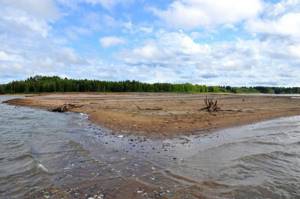
A reservoir rich in a variety of fish in the Moscow region is the Verkhneruzskoye Reservoir. Fishing, reviews of which are always enthusiastic, is more interesting in the summer. Pike perch, ide, pike and other fish bite well. Lots of carp fish. Fishing for ide occupies a special place. There are not many places where he bites well. And there is a lot of him in the reservoir, and he willingly takes bait. Therefore, ide lovers prefer to catch this fish here.
How to get to the Verkhneruzskoye Reservoir
Directions to the Verkhneruzskoye Reservoir:
- by electric train from Rizhsky station to Shakhovskaya station,
- then take a bus in the direction of Petushki to the village of Merklovo,
- then you will have to walk 3.5 km to the village of Filenino.
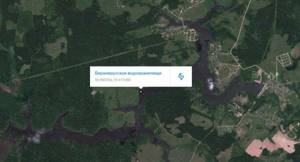
If you get there by your own transport, then you need to go along the Riga highway through Shakhovskaya and Sereda. After turning to Petushki, the next village will be Merklovo, from which the road will go to Filenino. There are 50 overnight accommodations at the Fileninsky fishing base. Fishing with vouchers.
How to get to the reservoir?
One of the favorite places for fishermen in the Moscow region is the Verkhneruzskoye Reservoir. How to get there? There are very few access points to the reservoir, so fishing in the reservoir as wild people is troublesome. But it has a special base created by the Moscow Society of Fishermen and Hunters. It is located in the village of Filenino.
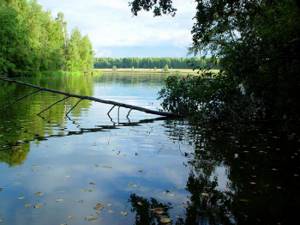
You need to go to the Verkhneruzskoye Reservoir from the town of Shakhovskaya along the Riga Highway. Turn to Uvarovka, and to the village. Sereda turn off to the village of Merklovo. There is another turn to the village of Filenino. You can purchase a ticket to the base located there in advance. If desired, you can rent boats.
The reservoir can also be reached from the villages of Sutoki and Shchemelinki. They are easily accessible from Moscow by train departing from Rizhsky Station. There are several routes, including buses from the Tushinskaya station. They all make stops in the listed villages. You can get to the lower part of the reservoir by car, along the canal to the Novoaleksandrovka tract, which is located near the village of Maloe Krutoe.
